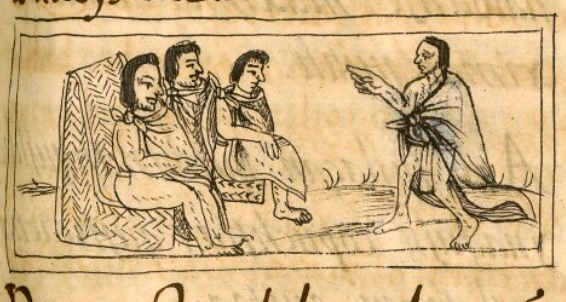mapilhuia (FCbk6f50r)
This iconographic example, featuring someone pointing a finger (mapilhuia) at others, is included in this digital collection for the purpose of making potential comparisons with hieroglyphs. The term selected for this example comes from the keywords chosen by the team behind the Digital Florentine Codex. There is no gloss. This example shows a man wearing a cape (probably a tilmatli, suggesting an elite status). He has his right arm raised, and he points to three other caped, elite men (as shown in the contextualizing image). At least one and perhaps all three of the other men are sitting on an icpalli (woven seat) that has a petlatl extending toward the gesturing man. Together, the seat and the mat are indicative of governing power. In this case, the hand seems extra large, which draws attention to it.
Stephanie Wood
The pointing finger is a theme that is worth following, because it relates to having a voice and to power and authority. It is a gesture that Nahua tlacuilos show to have been used by certain Nahuas and Spanish colonial officials, alike.
Stephanie Wood
1577
Jeff Haskett-Wood
dedo, dedos, mano, manos mapilli, gestos
mapilhuia (or mahpilhuiā, with the glottal stop and vowel length), to point a finger at someone, https://nahuatl.wired-humanities.org/content/mapilhuia
indicar con el dedo
Stephanie Wood
Available at Digital Florentine Codex/Códice Florentino Digital, edited by Kim N. Richter and Alicia Maria Houtrouw, "Book 6: Rhetoric and Moral Philosophy", fol. 50r, Getty Research Institute, 2023. https://florentinecodex.getty.edu/en/book/6/folio/50r/images/0. Accessed 5 July 2025.
Images of the digitized Florentine Codex are made available under the following Creative Commons license: CC BY-NC-ND (Attribution-NonCommercial-NoDerivs 4.0 International). For print-publication quality photos, please contact the Biblioteca Medicea Laurenziana ([email protected]). The Library of Congress has also published this manuscript, using the images of the World Digital Library copy. “The Library of Congress is unaware of any copyright or other restrictions in the World Digital Library Collection. Absent any such restrictions, these materials are free to use and reuse.”





